You’ve heard that marketing automation can help you nurture leads, increase your conversions, and grow your revenues… without spending more on advertising.
According to Lenskold Group, 63% of companies that are outgrowing their competitors have adopted marketing automation.
In the B2B world, DemandGen Report found that 67% of marketers see at least a 10% increase in sales opportunities with lead nurturing—a core feature in marketing automation tools.
It’s no surprise, then, that companies are intrigued. Google Trends shows that global annual searches for “marketing automation” have been growing steadily for nearly a decade.
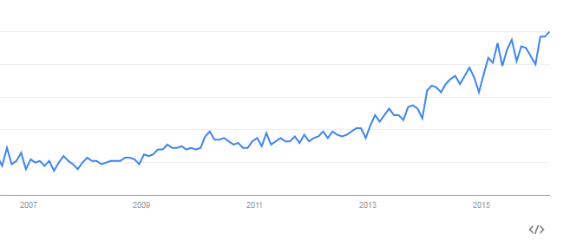
And yet, when it comes to actually implementing marketing automation software, it can be hard to know where to begin.
Neil Patel sums up the challenge bluntly in his Definitive Guide To Marketing Automation:
“Here’s the biggest problem with marketing automation today. It’s entirely software driven with large companies producing the thought leadership. It’s easy to feel lost in technical jargon.”
In this post, we’ll aim to cut through the jargon and give you a defined playbook of seven automated marketing campaigns that you can set up in just a few days on any major marketing automation tool.
- Personalized Call To Action
- Educational Email “Mini Courses”
- Automatic Broadcast Resend
- Pull-Back Campaigns
- Automatic List Pruning
- Post-Purchase Check In
- Warm Prospect Outreach
1. Personalized Call To Action
This hack will give you an unfair advantage over your competition.
Chances are, most marketers in your industry send the same newsletter to everyone on their list. Customers get the same content as leads. And leads get the same content as dead email subscribers.
Personalized calls-to-action flip this model on its head.
When you set up personalized calls-to-action, your recipients get email content that changes based on their stage in the sales funnel. This means that every lead gets the perfect “next step” you want them to take.
For example, let’s say you’re a SaaS marketer.
You could add a P.S. to your weekly newsletter that changes for leads (P.S. “Start your 14-day trial today”) and existing customers (P.S. “Learn more about our Pro plan”).
Your execution will depend on your marketing automation platform. Most automation tools with this capability let you create dynamic content with simple if-then logic. And you can often copy and paste pre-written shortcode to build your dynamic content. No coding required.
Here’s what the above example would look like in your email editor using Liquid markup:
{% if subscriber.tags contains “Lead” %}
P.S. Start your 14-day trial:
{% if subscriber.tags contains “Trial” %}
P.S. Learn more about our Pro Plan:
{% if subscriber.tags contains “Pro plan” %}
P.S. Learn more about our Business Plan:
{% elsif subscriber.tags contains “Business plan}
Even if 90% of your email content is the same, personalizing your CTAs can give you a big boost in conversions.
In a study of more than 93,000 calls-to-action, HubSpot found that CTAs targeted to the user had 42% higher conversions than calls-to-action that were the same for all visitors.
If you want to increase your conversions in email, personalizing your calls-to-action (for most businesses) is low-hanging fruit.
2. Educational Email “Mini Courses”
Many marketers these days obsess over email list growth. But there might be one KPI that marketers struggle with even more than turning website visitors into subscribers.
Converting subscribers into paying customers.
According to Ascend2, B2B marketers say that the most useful metric for measuring marketing automation performance is conversion rate.
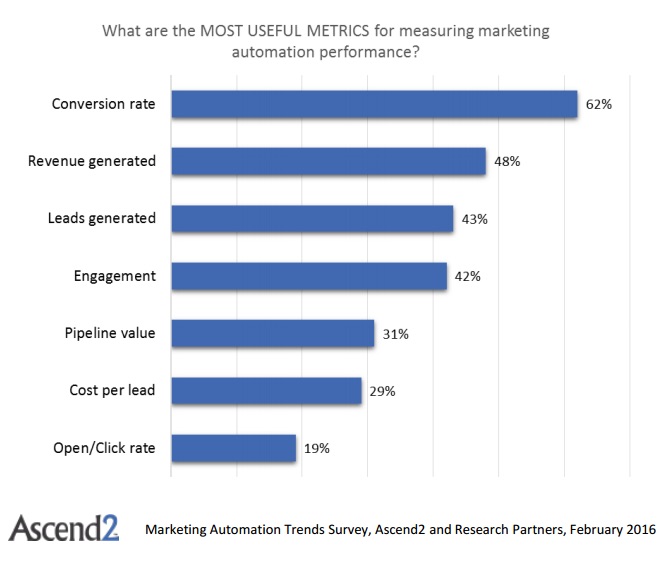
There’s no “one size fits all” approach to converting email subscribers. But one way to cut through the noise in the inbox, build trust, and qualify more marketing leads is to craft an authoritative email mini course.
Email mini courses are email drip campaigns that deliver one lesson per day, usually for five or seven days, to your prospects on a topic they care about.
At Close.io, CEO Steli Efti offers a free mini course on startup sales. Naturally, subscribers who want to improve their sales also want to hear about Close.io, a SaaS platform for sales professionals.

Email mini courses also have a subtle, powerful benefit.
They train people to open and engage with your emails.
This point can’t be overstated.
When you grow your list with a traditional lead magnet like a free ebook, you often find that your open rates fall off a cliff after several follow ups. The truth is, sometimes people don’t expect or want to hear from you. They just wanted the free ebook.
Mini courses, on the other hand, flip this script.
In order for people to get the lessons in your course, they need to read your emails. This trains subscribers to open, click, and reply to your marketing message. And isn’t that the whole point of building a lead magnet in the first place?
For B2B marketers, DemandGen Report found that lead nurturing results in 50% more sales-ready leads at 33% lower cost per lead. Try nurturing your leads with a five or seven-day automated email course, and watch your conversions increase.
3. Automatic Broadcast Resend
Imagine if you could get 30% more opens on any email you send.
That means your next webinar announcement, major product launch, or one-day sale would get 30% more email traffic.
With the Automatic Broadcast Resend hack, this is possible.
SumoMe co-founder Noah Kagan popularized this hack and summed up his ROI like this:
“1 minute of work = 7,028 more people read my email.”
Here’s how you set this up:
The next time you send a critical broadcast, wait a few days, then create a new email list from the people who didn’t open it.
Then just change the subject line and send the same email to the folks who missed the first one. This re-send can result in 30% more opens (and a double-digit increase in conversions) on email campaigns. And most marketers aren’t doing it.
Some automation platforms let you automate this with a few clicks. If you’re on a platform that does this, you can simply enter your second subject line, choose a time and day, and queue up a re-send at the same time you schedule any broadcast.
4. Pull-Back Campaigns
According to BI Intelligence, online retailers lose a startling $4 trillion per year in revenue due to abandoned shopping carts. Even worse, an estimated 63% of that revenue is recoverable.
Over the years, ecommerce companies have come to realize that cart abandonment is a problem. But fewer marketers have a strategy to address page abandonment.
Suppose someone visits your pricing, services, or demo scheduling page—then leaves without converting. They’re clearly interested in your product or service. And if you have remarketing campaigns set up, your prospect will see your ads.
Remarketing can help, but according to Close.io, following up with leads within 5 minutes makes them 100X more likely to convert than following up within one hour.
That’s where the pull-back campaign comes in.
Pull-back campaigns are automated emails designed to “pull” prospects back to a key page on your website, triggered minutes (or seconds) after they abandon the page.
Note: Prospects need to be on your email list for you to trigger pull-back campaigns. Technically, subscribers receive a browser cookie from your automation software (either when they first subscribe, or anytime they click through from an email sent by the tool) that identifies them as a subscriber. Then, you can set up rules to trigger email pull-back campaigns when they visit—and abandon—specific pages on your website.
Chris Schwarz from Kwasi Studios received the following pull-back campaign from Amazon several days after looking at digital cameras without buying:
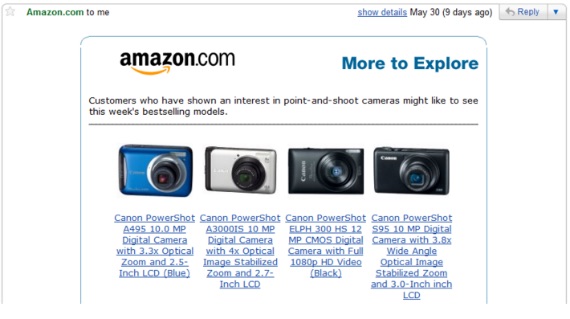
When it comes to crafting your campaign, you have a few options. In general, it’s a good idea to address objections that cause people to abandon your website in the first place.
You could write:
- “I lead our Search Engine Optimization team. When’s a good time to set up a consultation (totally on us) about improving your organic traffic and revenue?”
- “We offer free shipping in the domestic USA. Click here to shop now.”
- “After you start your trial, we send you a reminder email before we charge you. Is there anything holding you back from trying the software today?”
Focus on giving a helping hand, and make yourself available to answer any questions.
If you have a high customer lifetime value, this campaign can drive significant ROI by reengaging “silent” leads on your website with perfect timing.
5. Automated List Pruning
You know those subscribers on your email list who never open your emails?
They’re probably hurting your business more than you think.
Here’s the truth about inactive subscribers:
Low engagement hurts your deliverability across the board.
Here’s how Unbounce sums up the problem:
“ISPs will look at who you are sending to, how often, the number of abuse complaints from sends and whether email is opened or clicked on. All of these factors determine your reputation with your ISP and affect whether your emails are delivered to your subscribers’ inboxes.”
Here’s the key phrase:
“ISPs will look at… whether email is opened or clicked on.”
This means that, even if people aren’t marketing your email as Spam, simply not opening your email can hurt your deliverability to even your most engaged subscribers.
The solution is to add a trigger that automatically tags folks who haven’t opened your past 10 emails. From there, you can send them to verify that they still want to hear from you.
Crunchbase does a great job with their automatic verification. This keeps their list clean and their deliverability high for all subscribers.
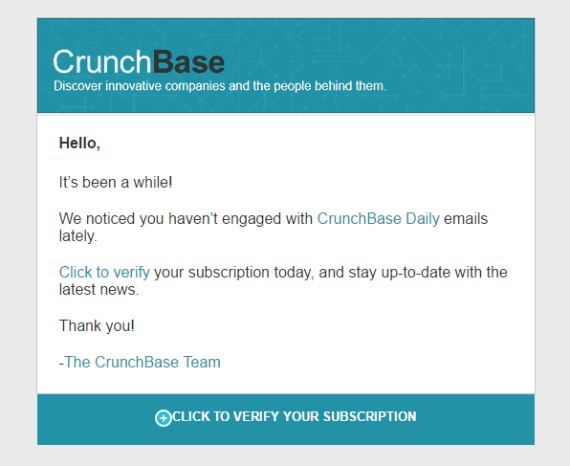
Again, your implementation will depend on your automation tool. Some platforms have built-in pruning operations, which make it dead simple to clean your list with one click.
With other tools, you’ll have to manually execute this—but the ROI is worth it.
6. Post-Purchase Check In
This campaign is simple. And deceptively powerful.
After you pick up a new customer, at minimum, you should send a goodwill email 14 days later that says, “hey, it’s been 14 days—I just wanted to check in and see how it’s going for you.”
The check-in email has become common in SaaS. But in other industries—like ecommerce, online courses, and consulting—it’s shocking how few businesses follow up with customers and ask if they’re enjoying their purchase.
Sean Fioritto, author of the ebook Sketching With CSS, used the post-purchase check-in to campaign generate over 100 testimonials for his ebook.
When readers buy the ebook, Sean’s automation software waits 14 days after the purchase, then triggers the following email:
Hey,
You picked up a copy of Sketching with CSS a couple weeks ago. One of the advantages of buying a book directly from the author is, well, me. :- )
I respond to every email and I love hearing from readers.
So how’s it going so far?
When Sean gets positive replies, he simply replies and asks for permission to use people’s quotes as testimonials. Most customers are fine with this. And they give Sean all the social proof he needs for future marketing campaigns.
According to Marketing Metrics, “the probability of selling to an existing customer is 60 – 70%, whereas the probability of selling to a new prospect is 5-20%.”
Use the post-purchase check-in campaign to nurture your customers and set the stage for repeat business. This one should take less than an hour to set up.
7. Warm Prospect Outreach
Are you using lead scoring at your company?
Lead scoring separates marketing automation tools from traditional email marketing software. Lead scoring assigns a score to contacts in your database, based on their behavior (such as opening and clicking emails, email inactivity, visiting your Pricing page twice in one week, downloading guides, or just about any other action you can track with a piece of JavaScript on your website).
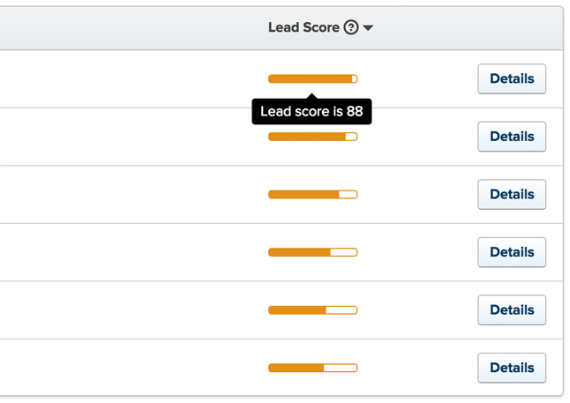
When a contact reaches your pre-defined lead score (say, 100), you can trigger actions.
Depending on your business, you might want to take hot leads and:
- add them to your CRM and assign them to a team member
- move them to a sales-focused drip campaign with case studies
- Move them to a campaign that syncs with Facebook custom audiences
The possibilities are endless.
You can also send an automated direct outreach email, like Beachhead.io:

Beachhead, a consultancy, uses lead scoring to reach out to high-value prospects who consume their content. If someone downloads five of your six whitepapers and views your pricing page in one week, you can bet they’re interested in your product or service.
Lead scoring lets you automate your direct outreach emails, so they engage warm leads even while you’re not working.
Conclusion
More and more, marketers are moving away from the “email blast” and sending more targeted, relevant, and automated emails.
According to Ascend2, 76% of companies in 2016 say marketing automation is “very important” to their overall marketing performance (up 11 percentage points from 2015).
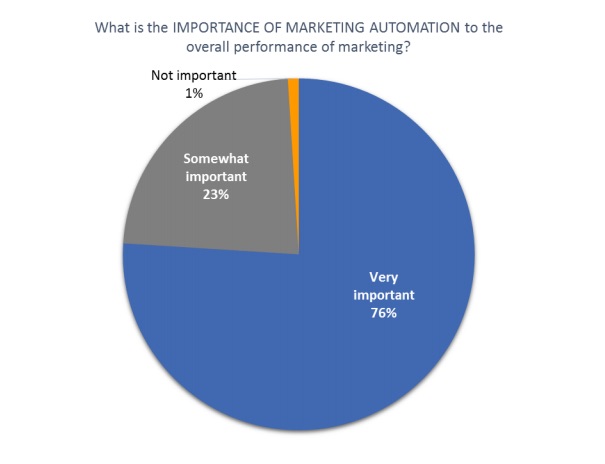
The problem for most marketers is that marketing automation can be confusing.
While social media and content marketing are highly visible, marketing automation often works in the background, making it harder for marketers to study.
With the 7 campaigns above, you should have a better idea of what’s possible, and some concrete steps to increase conversions and automate your marketing.
About the Author: Rob Walling is an angel investor, podcaster, author, and serial software entrepreneur who most recently started Drip, a lightweight marketing automation tool. You can follow him on Twitter @robwalling.